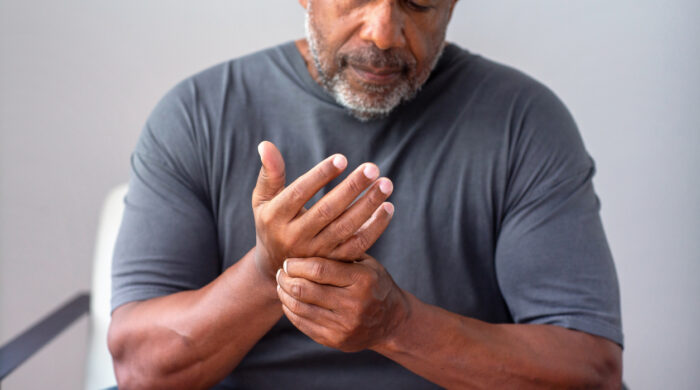In the US, almost 25% of adults have arthritis, making it a leading cause of disability, according to the CDC. It affects people’s ability to work or play and decreases their quality of life.
Arthritis is inflammation of joints that causes swelling, stiffness, and pain, decreases mobility, and limits daily activities. There are more than 100 types of arthritis, but just a few types are the most common.
Common types of arthritis and their characteristics
Of the many types of arthritis, there are four that are diagnosed most often, plus one disorder that is often associated with it. The most common types of arthritis are osteoarthritis, rheumatoid arthritis, psoriatic arthritis, gout, plus fibromyalgia.
- Osteoarthritis (OA) is the most common type of arthritis and is what most of us probably think of when we think of arthritis. OA affects the whole joint, where the cartilage degenerates and generally gets worse over time. Pain often starts in the joint at the base of the thumb, in the knees, or low back.
Osteoarthritis can feel like ‘just a part of growing older’ for many people, and its onset is associated with one’s family health history, past injuries, and general wear and tear on joints when a person was younger.
- Rheumatoid arthritis (RA) is caused by an autoimmune problem where the immune system attacks the body’s joint tissue, causing the joint lining to become inflamed. In cases of RA, organs may also be affected. Joint swelling and morning stiffness that lasts longer than 30 minutes are hallmarks of RA.
- Psoriatic arthritis is also an autoimmune disease. Unlike RA, it can affect one’s skin in addition to the joints. So someone affected by psoriatic arthritis may also see thick, scaly skin rashes and irritation along with joint pain. Small or large joints may be affected.
- Gout is inflammatory arthritis caused by an accumulation of uric acid in the joints. Like other forms of arthritis, it’s known to ebb and flow in severity in flare-ups. It commonly affects one joint at a time, often the big toe, other toes, or the ankles and knees, hands or wrists.
- Fibromyalgia, is a disorder causing more widespread pain throughout the body. While not arthritis itself, it often co-occurs with arthritis.
The primary symptoms of fibromyalgia can be less centralized, with general pain and sensitivity presenting throughout the body. It is associated with further symptoms like fatigue, trouble concentrating, and sensory sensitivity.
Fibromyalgia can run in families and is triggered by other diseases such as rheumatoid arthritis. It is often thought of as a ‘diagnosis of exclusion,’ where other causes of the symptoms can be ruled out.
Risk factors that increase your chances of getting arthritis
For many people, the chance of getting arthritis comes down to genetics, injury history, and the wear and tear they’ve had on their joints over the course of life.
There are also additional risk factors that may contribute to its onset. Understanding the risk factors, and which ones you can control, can be helpful in preventing, or minimizing, the impact of arthritis as you age.
Factors associated with an increased likelihood of developing arthritis include:
- Past injury: A previous injury increases the chance of developing osteoarthritis at the corresponding joint. Torn knee ligaments or broken wrists or ankles are common suspects.
- Sex: Rheumatoid arthritis is more common in women, while gout is far more common in men.
- Weight: Increased weight increases the stress on joints, which increases the chance of developing arthritis from wearing them down. Knee joints are especially susceptible to developing arthritis in these instances.
- Smoking: Along with its many negative health impacts, smoking increases the risk of rheumatoid arthritis and can exacerbate pre-existing RA.
- Certain occupations or activities: jobs or recreational activities that require repetitive movement puts added stress on joints, and over time those joints can become arthritic. Excessive high-impact activities or repetitive squatting and kneeling over time can increase wear on your knees, hips, and ankles, even without an injury.
Diagnosing and Treating Arthritis
If you find yourself experiencing joint pain or stiffness that you suspect might be the beginning of arthritis, it’s best to seek care sooner rather than later.
WWMG’s experienced rheumatologists can assess your symptoms and perform imaging exams of your bones and soft tissues to identify if and/or what type of arthritis you have, and how extensive it is.
Treatments will vary depending on the type of arthritis, but the main goal is always to reduce pain and degeneration, and to manage symptoms. As with many instances of pain, early intervention is important. Your quality of life will be higher for longer if you address the pain and seek treatment before it gets worse. Arthritis can’t be cured, but with expert help, it can be managed and mitigated.
If you’re experiencing symptoms of arthritis or have a family history and want to discuss your risks, request an appointment today with a Western Washington Medical Group rheumatologists. Our skilled specialists will offer you comprehensive assessment of your condition, and work with you to create an individualized treatment plan specifically for your needs.
